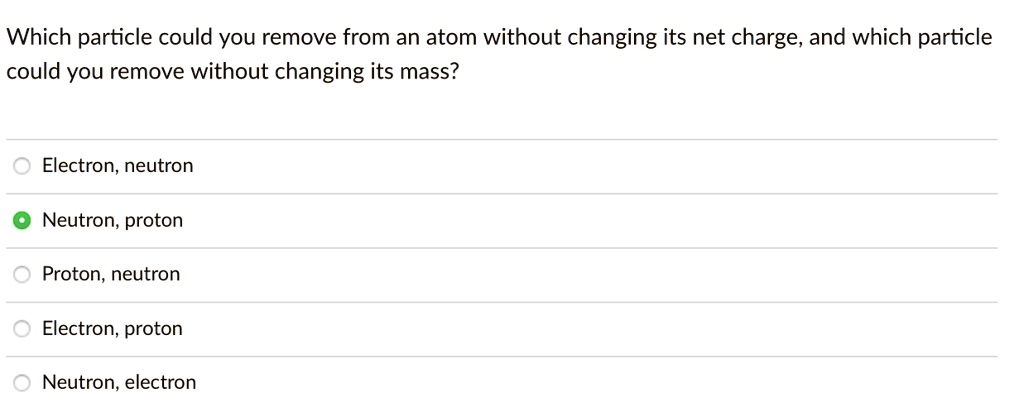In the intricate world of atomic physics, the subatomic particles that compose an atom—namely protons, neutrons, and electrons—play pivotal roles in determining its properties and behavior. While each particle holds significance, the electron stands out as the one easiest to remove from an atom, giving rise to a myriad of essential phenomena within the realms of chemistry and physics.
To commence our exploration, it is crucial to delineate the fundamental characteristics of these subatomic particles. Protons, residing in the nucleus, bear a positive charge and are essential in defining an element’s atomic number. Neutrons, alongside protons, contribute to the atomic mass but are neutral in charge. Electrons, in contrast, are negatively charged and exist in discrete energy levels outside the nucleus. This distinct arrangement establishes a correlation between an atom’s mass, its overall charge, and its chemical properties.
The relative ease with which electrons can be removed from an atom owes itself to their positioning in the atomic structure. Electrons are situated in a probabilistic cloud around the nucleus, defined by quantum mechanical principles. This positioning is a manifestation of both energy levels and electron affinities, which are crucial in understanding why electrons are more susceptible to removal compared to their heavier, positively charged counterparts.
When addressing the circumstances under which electrons can be extricated, one must consider ionization energy—the energy required to remove an electron from an atom. A lower ionization energy signifies that an electron can be relatively simply removed. Alkali metals, for instance, have one electron in their outermost shell and exhibit notably low ionization energies. The removal of this outer electron engenders the formation of cations, positively charged ions that fundamentally alter the element’s reactivity and interaction with other atoms.
An illustrative case emerges when examining the behavior of sodium (Na). Possessing a lone electron in its outermost shell, sodium readily relinquishes this electron, becoming a sodium ion (Na+). This uncomplicated electron removal is what characterizes the element’s strong metallic behavior and its propensity to participate in ionic bonding, a cornerstone of innumerable chemical reactions.
Conversely, the removal of protons or neutrons is significantly more arduous. Protons contribute to the atom’s positive charge and are tightly bound within the nucleus by the strong nuclear force, a formidable interaction that operates at very short ranges. Neutrons, devoid of charge, similarly experience this binding force. Changing the number of either protons or neutrons typically results in transmutations that create entirely different elements or isotopes, thus emphasizing the stability that the nucleus imparts.
Another noteworthy aspect of electron behavior is their involvement in chemical bonds. The ease with which electrons can be transferred or shared between atoms underpins the principles of chemical reactions. For example, in covalent bonding, atoms share electrons, thus forming molecules. This sharing facilitates a range of molecular interactions that are fundamentally different from those arising through ionic bonding, showcasing the versatility of electron dynamics in chemical processes.
Electrons also play a critical role in the realms of electricity and magnetism. Their mobility under the influence of an electric field gives rise to electrical conductivity. In conductors, such as metals, electrons wander freely, allowing for efficient charge transport. This characteristic is virtually non-existent for protons and neutrons, which remain fixed within the nucleus. As such, the fundamental principles governing electrical phenomena are inherently linked to the behavior of electrons.
Moreover, the removal of electrons carries profound implications in the context of plasma physics and astrophysics. When atoms lose electrons, they can become ionized, creating a plasma state—a condition prevalent in stars, including our own Sun. In these extreme environments, where temperatures soar, electrons are stripped from their nuclei, producing a state of matter that is often referred to as the fourth state of matter. This dynamic state has consequences not only for astrophysical models but also for understanding cosmic phenomena.
In the arena of modern technology, the capacity to manipulate electron removal is invaluable. The principles governing this process underpin myriad applications, ranging from semiconductors in electronics to targeted therapies in medical treatments. By understanding how to control the removal of electrons, scientists and engineers can tailor materials and devise new technologies that advance industries and enhance lives.
In conclusion, while protons and neutrons serve foundational roles within the atomic nucleus, electrons occupy a unique and less tightly bound domain around the nucleus, rendering them the most facile particles to remove from an atom. This ability to readily remove electrons underpins a multitude of scientific phenomena, from chemical bonding to electrical conductivity. The implications extend across disciplines, offering a profound understanding of atomic behavior and contributing substantially to our technological advancements. Indeed, the electron’s malleability invites a shift in perspective—highlighting not only its fundamental role in defining matter but also its dynamic capability to foster interactions that shape our universe.












